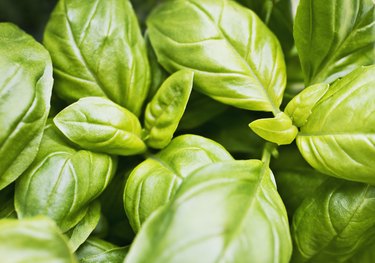
Of the numerous different types of basil, the difference between sweet basil and Genovese basil is hardly discernible in taste, unless you have a very sophisticated palate. Sweet basil (Ocimum basilicum) is the term for common basil, while Genovese basil (Ocimum basilicum 'Genovese') is a specific cultivar. These types do differ slightly in appearance, and both are superb additions to pesto, Italian sauces or splashed with olive oil and aged Balsamic vinegar and served with mozzarella cheese and thick sliced tomatoes.
A prodigious plant in either an outdoor herb garden in U.S. Department of Agriculture hardiness zones 4-10, or indoors on a sunny shelf, basil varieties are the easiest herb to grow and provide months of delicious flavors.
Video of the Day
Video of the Day
History of Basil
Originating in India, Southeast Asia and Central Africa, basil, a member of the mint (Lamiaceae) family, has royal roots. The name "basil" itself comes from the Greek word "basileus" which means "king." The herb is cross-cultural, with significance in all manner of religious practices, from embalming mummies and giving them a sendoff that ensures a safe journey into the afterlife, to the French belief that basil grew on the original cross of Christ. Jewish folklore contributes the idea that it quells hunger during times of fasting, and in Portugal, the fragrant green leaves are symbols of love presented during special Saints' Days.
Traveling along the historic trade routes, basil found its way to Britain in the 16th century, and finally arrived in North America with the first settlers to the Massachusetts Bay Colony in 1621. In spite of its mythical history of fending off dragons or warding off the devil, basil today is one of the world's most popular culinary herbs.
Difference Between Sweet Basil and Genovese
Sweet basil is the most common of all basil varieties. The leaves are medium green in color, and the leaf has a slight bow, similar to a cup. It has been known to repel mosquitos and is the variety most found on the shelves in a grocery store produce section. It has a subtle hint of pepper and mint and a strong flavor of anise. Rub it between your fingers and sniff the spicy, heady aroma.
Genovese basil has leaves that are slightly larger than sweet basil; further, they are flatter and come to a point. It is more aromatic than sweet basil and has dark green, shiny leaves. The taste of Genovese basil has been described as having hints of mint and clove while at the same time being peppery and spicy. Both varieties are interchangeable with only a slight difference in taste.
Growing Basil Varieties
Basil is a warm weather perennial herb. It blooms from mid-to late summer after displaying a shaft of small white or lavender flowers. Nip the flowers off to encourage the plant energy to focus on the leaves. Basil needs six to eight hours of sun daily and is ideal for container gardening, outdoor growth or hydroponics with a grow light that shines at least 15 hours daily. It doesn't need nitrogen rich soil or earth that is heavily treated with organic matter.
Container-grown basil needs at least 6 inches for the roots to expand. The more you prune the leaves, the more lush growth appears. Keep the soil just moist but not wet and spray with compost tea or liquid seaweed extract twice during the growing season. The pot needs a sunny window, medium water and can be grown in the winter from summer cuttings or seeds.